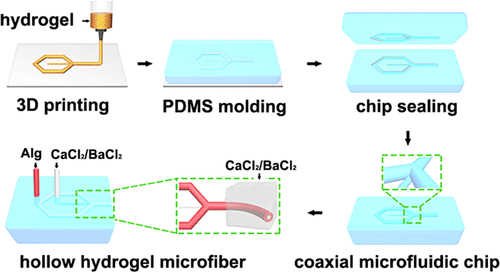当前位置:
X-MOL 学术
›
ACS Biomater. Sci. Eng.
›
论文详情
Our official English website, www.x-mol.net, welcomes your
feedback! (Note: you will need to create a separate account there.)
Facile Fabrication of Hollow Hydrogel Microfiber via 3D Printing-Assisted Microfluidics and Its Application as a Biomimetic Blood Capillary
ACS Biomaterials Science & Engineering ( IF 5.4 ) Pub Date : 2021-09-10 , DOI: 10.1021/acsbiomaterials.1c00980 Dongxu Lan 1, 2 , Yulian Shang 1, 2 , Hongxian Su 1, 2 , Minhua Liang 1, 2 , Yang Liu 1, 2 , Haofei Li 1, 2 , Qi Feng 1, 2 , Xiaodong Cao 1, 2, 3 , Hua Dong 1, 2, 4
ACS Biomaterials Science & Engineering ( IF 5.4 ) Pub Date : 2021-09-10 , DOI: 10.1021/acsbiomaterials.1c00980 Dongxu Lan 1, 2 , Yulian Shang 1, 2 , Hongxian Su 1, 2 , Minhua Liang 1, 2 , Yang Liu 1, 2 , Haofei Li 1, 2 , Qi Feng 1, 2 , Xiaodong Cao 1, 2, 3 , Hua Dong 1, 2, 4
Affiliation

|
Simulating the structure and function of blood capillaries is very important for an in-depth insight into their role in the human body and treatment of capillary-related diseases. Due to the similar composition and structure, hollow hydrogel microfibers are well-recognized as potential biomimetic blood capillaries. In this paper, we report a novel, facile, and reproducible method to fabricate coaxial microfluidic chips via 3D printing-assisted soft lithography and then hollow hydrogel microfibers using the as-prepared coaxial microfluidic chips. Instead of traditional photoresist-based lithography, 3D printing of gelatin hydrogel under various extrusion pressures is used to construct sacrificial templates of coaxial microfluidic chips. Various solid and hollow hydrogel microfibers with complicated and hierarchical structures can be obtained via multitype coaxial microfluidic chips or a combination of coaxial microfluidic fabrication and post-treatment. The as-formed hollow hydrogel microfibers are evaluated in detail as biomimetic blood capillaries, including physicochemical and cytological properties. Our results prove that the hollow hydrogel microfibers exhibit excellent mass transport capacity, hemocompatibility, semipermeability, and mechanical strength, and their barrier function can be further enhanced in the presence of endothelial cells. Overall, our 3D printing-assisted fabrication strategy provides a new technique to construct microfluidic chips with complicated 3D microchannels, and the resulting hollow hydrogel microfibers are promising candidates for blood capillaries.
中文翻译:

通过 3D 打印辅助微流体轻松制备空心水凝胶微纤维及其作为仿生毛细血管的应用
模拟毛细血管的结构和功能对于深入了解毛细血管在人体中的作用和治疗毛细血管相关疾病非常重要。由于相似的成分和结构,中空水凝胶微纤维被公认为潜在的仿生毛细血管。在本文中,我们报告了一种新颖、简便且可重复的方法,通过 3D 打印辅助软光刻技术制造同轴微流控芯片,然后使用所制备的同轴微流控芯片制造中空水凝胶微纤维。代替传统的基于光刻胶的光刻,明胶水凝胶在各种挤压压力下的 3D 打印用于构建同轴微流控芯片的牺牲模板。通过多类型同轴微流控芯片或同轴微流控制造与后处理相结合,可以获得具有复杂分层结构的各种实心和空心水凝胶微纤维。形成的空心水凝胶微纤维作为仿生毛细血管进行了详细评估,包括物理化学和细胞学特性。我们的研究结果证明,中空水凝胶微纤维表现出优异的传质能力、血液相容性、半透性和机械强度,并且在内皮细胞的存在下可以进一步增强其屏障功能。总体而言,我们的 3D 打印辅助制造策略提供了一种构建具有复杂 3D 微通道的微流控芯片的新技术,
更新日期:2021-10-12
中文翻译:

通过 3D 打印辅助微流体轻松制备空心水凝胶微纤维及其作为仿生毛细血管的应用
模拟毛细血管的结构和功能对于深入了解毛细血管在人体中的作用和治疗毛细血管相关疾病非常重要。由于相似的成分和结构,中空水凝胶微纤维被公认为潜在的仿生毛细血管。在本文中,我们报告了一种新颖、简便且可重复的方法,通过 3D 打印辅助软光刻技术制造同轴微流控芯片,然后使用所制备的同轴微流控芯片制造中空水凝胶微纤维。代替传统的基于光刻胶的光刻,明胶水凝胶在各种挤压压力下的 3D 打印用于构建同轴微流控芯片的牺牲模板。通过多类型同轴微流控芯片或同轴微流控制造与后处理相结合,可以获得具有复杂分层结构的各种实心和空心水凝胶微纤维。形成的空心水凝胶微纤维作为仿生毛细血管进行了详细评估,包括物理化学和细胞学特性。我们的研究结果证明,中空水凝胶微纤维表现出优异的传质能力、血液相容性、半透性和机械强度,并且在内皮细胞的存在下可以进一步增强其屏障功能。总体而言,我们的 3D 打印辅助制造策略提供了一种构建具有复杂 3D 微通道的微流控芯片的新技术,











































 京公网安备 11010802027423号
京公网安备 11010802027423号